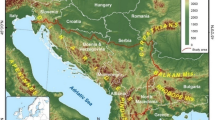Abstract
Wide karst plateaus extend in the carbonate rocks of the Grands Causses area, north of Montpellier (south of France). They are surrounded by a hard rock base that feeds important rivers, such as the Tarn River and tributaries, and crosses the plateaus creating deep gorges. The Larzac plateau, the most southern, makes a link with the Mediterranean region. It is traversed by one of the main national roads and another main road under construction from Clermont-Ferrand to Montpellier and Spain. The karst water resource of the plateau, from springs, is used as a water supply for the Millau area (30,000 inhabitants); but it also recharges surface rivers, mainly during the summer and fall when the water level is low, in a region that is well known for water recreation activities, for fish farming and, above all, for sheep farming and Roquefort cheese production. The fundamental question was should the karst and its water resource be fully protected by strict regulations (for example as a nature reservation) in land-use management of the plateau based upon the knowledge of its hydrogeological functioning and its karst structure? Decisions, concerning the ∼500-km2 area were elaborated from detailed hydrogeological studies, which included natural and artificial tracing, analysis of karst aquifer functioning, landscape analysis, and risk assessment and mapping. Recommendations were proposed to local and regional decision makers to define what were the preferences in terms of water resource protection and water quality restoration. Following such an approach in a karst area is not easy for hydrogeologists or for decision makers. In non-karstic regions, protection zones currently extend over small areas of a few square kilometers, which can be easily placed under the control of a small municipality. In the present example, the main water supplies are two springs that recharge areas that extend respectively over 100 and 110 km2. Included are several municipalities, some of which use them for their water supply, whereas others are concerned with pollution risks and land management projects. The recent French Water Act, which considers water as a common heritage, allows for general management by all the users, and it deals with the water and the terrain in which it flows. The regulation tools seem very well suited to karst region management. However, time is needed to educate users and decision makers, and with the help of karst scientists, to work together in a framework that is larger than the usual municipal limits.
Similar content being viewed by others
Author information
Authors and Affiliations
Additional information
Received: 10 May 1999 · Accepted: 22 March 2000
Rights and permissions
About this article
Cite this article
Plagnes, V., Bakalowicz, M. The protection of karst water resources: the example of the Larzac karst plateau (south of France). Environmental Geology 40, 349–358 (2001). https://doi.org/10.1007/s002540000166
Issue Date:
DOI: https://doi.org/10.1007/s002540000166




